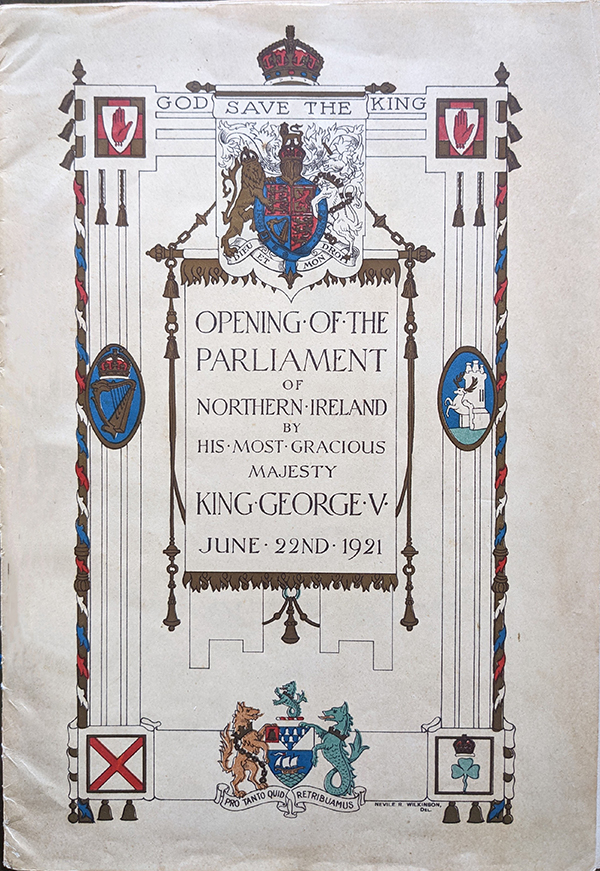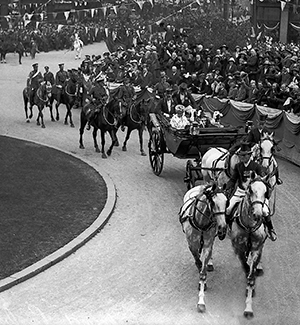‘Who is for the Empire and who is for the Republic?’—the 1921 elections to the Northern Ireland parliament
Published in Features, Issue 4 (July/August 2021), Volume 29By Elaine Callinan
In April 1921 Éamon de Valera outlined a scheme for Sinn Féin propaganda against partition and against a unionist victory for seats in the new Northern Ireland parliament. A sum of £2,000 was raised—the Dáil contributed £1,000 and Sinn Féin the other £1,000. That same month, James Craig, leader of the Ulster Unionist Party, called on nationalist Ireland to ‘swallow the Partition Act’ and cautioned fellow unionists that ‘failure to secure an effective working majority would mean immediate submergement in a Dublin Parliament’. Battle lines were drawn between nationalists and unionists to contest seats in the new northern parliament, and the fate of the six counties hung in the balance. Britain’s prime minister, David Lloyd George, had proposed two separate parliaments and governments for Ireland—one for the six north-eastern counties of Ulster and the other for the remaining 26 counties—in an attempt to ease the polarised positions of nationalists and unionists. The Act for the Better Government of Ireland (better known as the Government of Ireland Act) 1920 came into operation on 3 May 1921.
Parliamentary representation was increased for these elections, as the act provided for 52 MPs from eleven constituencies for a six-county northern parliament and 128 MPs from 28 constituencies for a 26-county southern parliament—although no elections took place for the latter, so Sinn Féin attained a walk-over with 124 seats, with the remaining four returning Unionists for Trinity College, Dublin. Representation from Ireland to Westminster was reduced from 105 to 46 MPs (33 from Southern Ireland and thirteen from Northern Ireland). The Single Transferable Vote-Proportional Representation (STV-PR) system was used for the Northern Ireland parliament elections, which took place on 19 May 1921.
To contest or not to contest …
‘Unless we are able to secure about one-fourth, or at least one-fifth—say ten members—I think it would be inadvisable to show up our weaknesses’, stated de Valera to all members of the Dáil ministry in January 1921, as he tried to decide whether Sinn Féin should challenge or boycott the northern elections. Ultimately he decided to contest, to show ‘unity of republican sentiment’, because to let the elections go by default could demonstrate that Sinn Féin had ‘given way to partition’. Despite the withdrawal of the Irish Parliamentary Party (IPP) from the southern elections, its candidates contested for the northern parliament. Constitutional nationalists had previously accepted the principle of temporary partition from the third Home Rule bill but they were opposed to permanent partition. Joseph Devlin, IPP MP, stated that the elections were a ‘fight against the establishment of the six-county parliament’. Southern unionists had argued for the postponement of the 1921 elections, but Ulster unionists—according to Edward Carson—believed it to be a struggle between ‘peace and anarchy, loyalty and disloyalty, the safety of life and property, and murder and assassination’.
On 6 April Devlin and de Valera decided to co-operate in an attempt to defeat unionists, agreeing to reject partition and abstain from the northern parliament. Thirty-two nationalist candidates ran as follows: Antrim 3, Armagh 3, Londonderry 4, Down 4, Fermanagh–Tyrone 7, Belfast West 4, Belfast East 2, Belfast North 2, Belfast South 2 and Belfast University 1. Voters were instructed to give their lower preferences to other nationalist candidates irrespective of party allegiance. The pact, however, was an uneasy alliance that was beset with schisms in policy and in a future vision for Ireland.
Craig issued a manifesto to the ‘Loyalist Electors of Northern Ireland’ (Belfast News-Letter, 9 May 1921), stating that it was ‘vital to record every single vote in favour of all the [unionist] candidates’ and to ‘vote for no others’. The 52 seats for the northern parliament were contested by 77 candidates with 40 unionists, twelve constitutional nationalists, twenty Sinn Féin, four Labour independents and one other independent.
Propaganda
‘Interest in the elections is becoming more intense’, stated the Irish Times on 17 May, but ‘in contrast to previous elections, there is a notable absence of election literature’. The Freeman’s Journal reported on 19 April that the homes of several Sinn Féin candidates and their solicitors were raided by Special Constables and election literature was captured, perhaps explaining the absence of posters and handbills. All candidates, political parties and their supporting organisations therefore focused on public speeches, canvassing and using editorials in newspapers, and a few used newspaper advertisements.
Partition versus anti-partition was the dominant propaganda theme. In a speech in north Antrim Devlin called for co-operation and support, urging all nationalists and unionists to come together in a ‘genuine Constituent Assembly’ to pursue an Irish settlement, claiming that ‘providence had fashioned this land to be one and indivisible’ (Irish News, 10 May, and Cork Examiner, 11 May). De Valera in an interview with an American correspondent maintained that ‘the Irish people would never accept it [partition]’. He also threatened that a boycott of Belfast goods would be imposed ‘if the Partition Act was put into effect’ (Irish Times, 18 May). Sinn Féin published a spurious newspaper named The Unionist and posted 20,000 copies into unionist strongholds in an attempt to sell their style of nationalism and disparage unionist electoral claims. They also placed advertisements in almost 50 northern newspapers.
In complete contrast, Craig’s election manifesto called for an ‘adhesion to the principle of loyalty—first to the Throne, then to our close connection with Great Britain, next to the British Empire, and, as a corollary to these, an earnest desire for peace throughout Ireland’. He saw the contest as putting a great single issue before the voters—‘Who is for the Empire and who is for the Republic?’ (Belfast News-Letter, 26 April). The crafty propaganda messages propagated against the third Home Rule bill were dusted down and revived by unionists for this ‘partition election’.

Above: Front cover of the running order for the opening of the Northern Ireland Parliament, 22 June 1921.
Canvassing was carried out extensively by all party volunteers and supporters. Public oratory by candidates and party leaders was bolstered by party symbols. According to the Ulster Herald, the display of Union Jacks was exceptionally flamboyant, women voters even appearing in dresses of red, white and blue. In some Belfast streets houses were ‘decorated with SF flags and the other half with Orange flags’.
Violence and intimidation
Catholics who had been expelled from the terrace streets of Ballymacarrett in the early 1920s after clashes with unionists made their way back from other parts of the city to vote. They were surrounded by hostile crowds and badly beaten, and three cars bearing voters were also ‘smashed up’. The Manchester Guardian declared that ‘rarely has there been an election fought with such ruthlessness, such corruption and such unfairness’, and added that ‘the Unionists converted the election into a fair imitation of what one supposes the Silesian plebiscite to have been like’. Evidence of similar attacks against unionists is difficult to find. Violence seems to have been confined to constituencies in Belfast, as polling in Londonderry, for instance, was carried out without incident. The Belfast News-Letter reported that, ‘generally speaking, the elections passed off quietly, but there were a few “scraps” here and there, and shots were fired on a couple of occasions by Sinn Féin gunmen’.
Sinn Féin maintained that their election campaign was hampered by violence, intimidation and gerrymandering, but lack of organisation in Ulster constituencies also added to their difficulties. Of the nineteen Sinn Féin candidates (excluding Queen’s University), eight were in gaol or interned and seven were ‘on the run’, which meant that they were not visible on election platforms and were represented by proxy.
The results

Above: George V in Belfast for the opening of the Northern Ireland Parliament on 22 June 1921. (Alamy)
‘Well done candidates. Well done workers. Well done loyalist voters. You won a loyal victory … We are still in the Empire, and there we will remain’, declared James Craig (Cork Examiner, 25 May 1921).
Turnout was high and every seat had been contested, and the final result was a unionist victory with 40 of the 52 seats, gaining 66.9% of the total vote. Sinn Féin won six seats with 20.5% of the votes, constitutional nationalists won six seats but with only 11.8% of the votes, and all independent candidates were defeated. The highest percentage of unionist votes was in east Ulster, corresponding closely with the population distribution of Protestants—although they were strong in all constituencies. They fielded 40 candidates and attained 40 seats, reaching the quota each time. Sinn Féin, on the other hand, were disappointed by the results, as they had invested considerable resources in their campaign.
Nationalists did not nominate enough candidates to challenge unionists, and this was also problematic when it came to transferring surplus votes under STV-PR. The low percentage of votes transferred suggests that ardent party views were held by the electorate in these constituencies. De Valera, therefore, did not get his hoped-for ‘one-fourth or at least one-fifth’, and certainly not his ten seats. It was evident that in 1921 north-east Ulster opinion had not changed since the advent of the third Home Rule bill in 1912.
Results of elections to the Northern Ireland parliament.
| Party | Seats | % of seats | First-preference votes | % of votes |
| Ulster Unionist Party | 40 | 76.9 | 343,347 | 66.9 |
| Sinn Féin | 6 | 11.5 | 104,917 | 20.5 |
| Constitutional nationalists [IPP] | 6 | 11.5 | 60,577 | 11.8 |
| Belfast Labour Party | 0 | 0 | 3,075 | 0.6 |
| Independents | 0 | 0 | 926 | 0.2 |
The results of this election allowed for the formal opening of the Northern Parliament by King George V in the council chamber of City Hall, Belfast, on 22 June 1921. The king, however, addressed only unionist MPs because Sinn Féin and constitutional nationalist MPs abstained from the new parliament. Some of the premises expressed in the Government of Ireland Act survived in the Anglo-Irish Treaty, which was signed on 6 December 1921.
Elaine Callinan is a lecturer in Modern Irish History at Carlow College, St Patrick’s.
FURTHER READING
E. Callinan, Electioneering and propaganda in Ireland, 1917–21: votes, violence and victory (Dublin, 2020).
K. Ineou, ‘Sinn Féin propaganda and the “Partition Election”, 1921’, Studia Hibernica 30 (1998–9).
M. Laffan, The resurrection of Ireland: the Sinn Féin Party 1916–1923 (Cambridge, 2005).
D.G. Pringle, ‘Electoral systems and political manipulation: a case study of Northern Ireland in the 1920s’, Economic and Social Review 11 (3) (1980), 187–205.
















